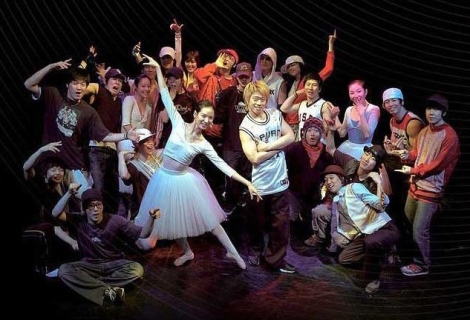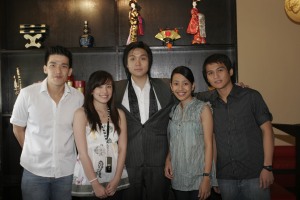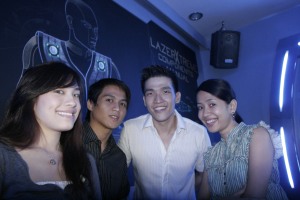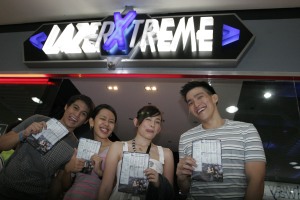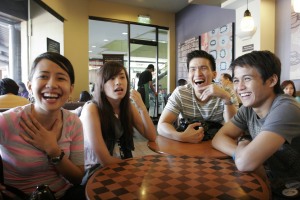I recently shifted my reading preference from fiction to non-fiction in a futile effort to increase my understanding of how our world operates. To shift from placebo to pabulum is penance for going through college drunk and disengaged.
I finished reading “Outliers” by Malcolm Gladwell and it tells the real story behind success. It was immensely provocative but I was hoping to find the panacea that should help me rise from mediocrity. As it turns out, the reason I’m not as successful as I want to be has a lot to do with my genealogy and my ethnicity’s cultural mores. And, it also has something to do about being in the wrong place in history. Just like what Tyler said in Fight Club, “We are the middle children of history…we have no great war, no great depression…our great war is with ourselves, our great depression, our lives…” Yikes.
Needless to say, the book was like a rug pulled under my hopes and dreams. But it was nothing an endorphin blast couldn’t cure. Nihilism and fatalism don’t stand a chance against an early morning run.
So I decided to pick up another book which should sound ridiculous especially for Bugs Bunny (or Elmer Fudd?). The book is “The World Is Flat” by Thomas Friedman. The book is more than 600 pages long and I am barely through page 330 after more than five weeks of sporadic reading sessions. Don’t get me wrong. It’s not a bad read at all. I’m just taking everything in because it may prove to be useful maybe 15 – 20 years down the road. Given our country’s charming backwardness, whatever I may learn should be automatically rendered ludicrous and way ahead of Filipino time. (Filipino time should be redefined from lateness to time that is stuck in concrete.)
That being said, I now sense that a career in soothsaying using only the Discovery Channel as a crystal ball and back issues of Wired Magazine as tarot cards entirely plausible. But only in the Philippines.
In the book the “World Is Flat,” a chapter entitled the Quiet Crisis takes a closer look at the state of education in the United States in relation to other countries emerging in a flattening world. In the US, there is a steady decline in the number of graduates in science and engineering. Inversely, there is an increase in job opportunities for science, math and engineering graduates because of the Internet’s second wind and advances in Information Technology. In a flat world where everything is being digitized, automated, outsourced, the need for brain power is progressively expanding. And this expansion is breaking down barriers and crossing geographic walls.
In US universities, the book also pointed out that there is a steady increase in science and engineering enrollees from other countries. Countries like India and China, two countries aggressively taking advantage of a leveled global playing field.
Here is what I think: technology has the power to discover new needs which spawn new technologies. It is a never ending virtuous cycle that will need more people to keep it going.
And where do we stand in this virtuous cycle? Unfortunately, we’re standing outside lining up for Pinoy Big Brother or playing basketball as a 5’7” center.
If we become a race of pampered celebrities and diminutive hard court heroes, can we find someone or something to blame? And can we compete with cheesy acting and fancy dribbling in a flattened, digitized, algorithm-obsessed world? You don’t have to be a soothsayer to be able to answer that question.
In the book, it says that IQ is not enough. What kids need to be successful in school are PQ and CQ—a passion quotient and a curiosity quotient. I will get back to that in a little bit.
In “Outliers,” it explains why the Chinese and the Koreans are statistically better in math compared to the rest of the European Hindu-Arabic oriented world. In China, for instance, converting numbers to words is much more logical compared with the European symbols. Chinese kids can actually do arithmetic using the words because it translates tightly into the numbers and vice-versa. Bottom line, Chinese kids tend to enjoy arithmetic more because it makes sense to them.
When I was a kid, I had a hard time grasping math and I consequently hated it. But I understood TV and enjoyed watching it. Go figure. You won’t need algebra to crack that equation.
We can’t change our number system but you can modify the environment your kids grow up in. As parents, the environment you create should be able to instill a PQ and a CQ that would help them thrive in a flat world. I don’t have a formula yet for this but a good start would be observing your kids and turning off the television.
And yes, our educational system will have to undergo some adjustments. It would be a shame to see intellectual nurturing go for naught because of an imperfect curriculum and underqualified educators. In some schools in Metro Manila, administrators are more concerned in leaving “tangible” legacies that cost millions of pesos to build. Meanwhile, the teachers are tripping on subject-verb agreements and the students are imbibing these costly mistakes.
A friend told me an interesting story about her Statistics class which is a pre-requisite for a Master’s Degree. She was sort of an anomaly in that class because she was the only English teacher in a class full of Accounting graduates. In quizzes, surprisingly, she always scores the highest with only 2-3 incorrect answers while the rest of the class barely makes the grade. A typical item would give parameters like, “Student A is ranked in the 80th percentile of the entire class. Choose the statement that holds true.” Options will include “Student A gets 80% of test questions correct…Student A is an above average student…etc.” Most of her classmates will get this question wrong.
Apologies if the sample above doesn’t make sense. I couldn’t remember the exact question and the list of options but the point I am trying to drive home is that success in school relies heavily on one’s ability to comprehend. The fact is: we have a lot of degree holders struggling with something as crucial as comprehension. And some of these degree holders will be teaching your kids.
The “Word Is Flat” also defined the three shifts in globalization. Globalization 1.0 is countries going global, 2.0 is corporations going global and 3.0 is individuals going global. We are in Globalization 3.0. When you think about it, this could be the big break that we need. This is our chance to compete in a leveled playing field. But if our educational system fails to make individuals globally competitive, we might miss out on this trend. Like we did on the first two. Yikes.
As always, I try to quell the onset of hopelessness with an adrenaline rush. I remember going out for an early morning jog and passing by a small group of joggers taking a break from their early morning workout. They were marveling at a gray, larger-than-life size statue of a moose. It was 6.00am in the morning and their well-rested, properly stimulated brains were engaged in an “erudite” debate. I overheard one girl arguing that it was a statue of a cow that grew magical antlers instead of normal horns. Another guy proudly contested. He said it was a moose because he saw the exact same thing on the Discovery Channel. Wow.
How do we turn off the TV when it does a better job in educating our people?
YIKES. I think jogging won’t cut it anymore. Maybe bungee jumping can do the trick.
Why I am blogging about this? I am not really sure. But if I only enjoyed math, maybe I would be able to draw the algorithm for a killer recommendation engine or a price finder/comparison engine that should help propel our website to global competitiveness.
